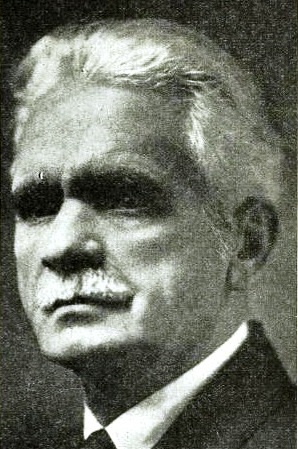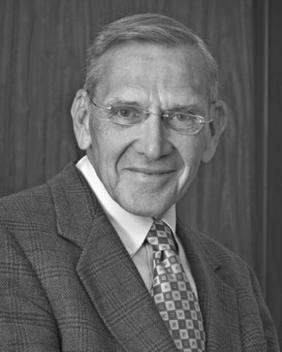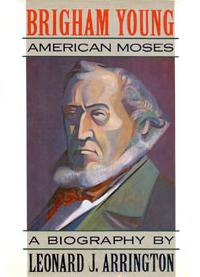
Brigham Young was an American religious leader and politician. He was the second president of the Church of Jesus Christ of Latter-day Saints, from 1847 until his death in 1877. During his time as church president, Young led his followers, the Mormon pioneers, west from Nauvoo, Illinois, to the Salt Lake Valley. He founded Salt Lake City and served as the first governor of the Utah Territory. Young also worked to establish the learning institutions that would later become the University of Utah and Brigham Young University. A polygamist, Young had at least 56 wives and 57 children. He instituted a ban prohibiting conferring the priesthood on men of black African descent, and led the church in the Utah War against the United States.

Leonard James Arrington was an American author, academic and the founder of the Mormon History Association. He is known as the "Dean of Mormon History" and "the Father of Mormon History" because of his many influential contributions to the field. Since 1842, he was the first non-general authority Church Historian for the Church of Jesus Christ of Latter-day Saints, from 1972 to 1982, and was director of the Joseph Fielding Smith Institute for Church History from 1982 until 1986.

Brigham Henry Roberts was a historian, politician, and leader in the Church of Jesus Christ of Latter-day Saints. He edited the seven-volume History of the Church of Jesus Christ of Latter-day Saints and independently wrote the six-volume Comprehensive History of the Church of Jesus Christ of Latter-day Saints. Roberts also wrote Studies of the Book of Mormon—published posthumously—which discussed the validity of the Book of Mormon as an ancient record. Roberts was denied a seat as a member of United States Congress because of his practice of polygamy.

The Encyclopedia of Mormonism is a semi-official English-language encyclopedia for topics relevant to the Church of Jesus Christ of Latter-day Saints. The five-volume texts have been digitized and are available for free online via the Harold B. Lee Library's official website.

Richard Lyman Bushman is an American historian and Gouverneur Morris Professor Emeritus of History at Columbia University, having previously taught at Brigham Young University, Harvard University, Boston University, and the University of Delaware. Bushman is the author of Joseph Smith:Rough Stone Rolling, an important biography of Joseph Smith, progenitor of the Latter Day Saint movement. Bushman also was an editor for the Joseph Smith Papers Project and now serves on the national advisory board. Bushman has been called "one of the most important scholars of American religious history" of the late-20th century. In 2012, a $3-million donation to the University of Virginia established the Richard Lyman Bushman Chair of Mormon Studies in his honor.
Historians of the Latter Day Saint movement are a diverse group of historians writing about Mormonism. Historians devoted to the history of the Latter Day Saint movement may be members of a Latter Day Saint faith or non-members with an academic interest. They range from faith-promoting historians to anti-Mormon historians, but also include scholars who make an honest effort at objectivity.

Jo Ann Barnett Shipps, known as Jan Shipps, is an American historian specializing in Mormon history, particularly in the latter half of the 20th century to the present. Shipps is generally regarded as the foremost non-Mormon scholar of the Latter Day Saint movement, having given particular attention to the Church of Jesus Christ of Latter-day Saints. Her first book on the subject was Mormonism: The Story of a New Religious Tradition published by the University of Illinois Press. In 2000, the University of Illinois Press published her book Sojourner in the Promised Land: Forty Years Among the Mormons, in which she interweaves her own history of Mormon-watching with 16 essays on Mormon history and culture.
Thomas Glen Alexander is an American historian and academic who is a professor emeritus at Brigham Young University (BYU) in Provo, Utah, where he was also Lemuel Hardison Redd, Jr. Professor of Western History and director of the Charles Redd Center for Western Studies. After studying at Weber State University (WSU) and Utah State University (USU), he received a PhD from the University of California, Berkeley in 1965. He taught history at BYU from 1964 until 2004, and served in the leadership of various local and historical organizations.

No Man Knows My History: The Life of Joseph Smith is a 1945 book by Fawn M. Brodie that was one of the first significant non-hagiographic biographies of Joseph Smith, the progenitor of the Latter Day Saint movement. No Man Knows My History was influential in the development of Mormon history as a scholarly field, though historians of Mormonism have since criticized the book for its methodological deficiencies, factual errors, and overt hostility to Smith.
New Mormon history refers to a style of reporting the history of Mormonism by both Mormon and non-Mormon scholars which departs from earlier more polemical or faith-based styles of history. Rather than presenting material selectively to either prove or disprove Mormonism, the focus of new Mormon history is to present history in a more humanistic and dispassionate way, and to situate Mormon history in a fuller historical context. Because it is a break from past historical narratives, new Mormon history tends to be revisionist. In many cases, the new Mormon history follows the perspectives and techniques of new history, including cultural history. The Mormon historian Richard Bushman described it as "a quest for identity rather than a quest for authority." New Mormon historians include a wide range of both Mormon and non-Mormon scholars, the most prominent of which include Bushman, Jan Shipps, D. Michael Quinn, Terryl Givens, Leonard J. Arrington, Richard P. Howard, Fawn Brodie, and Juanita Brooks.

History of Joseph Smith by His Mother is a biography of Joseph Smith, founder of the Latter Day Saint movement, according to his mother, Lucy Mack Smith. It was originally titled Biographical Sketches of Joseph Smith, the Prophet, and His Progenitors for Many Generations and was published by Orson Pratt in Liverpool in 1853.

Ronald Davis Bitton was a charter member and president of the Mormon History Association, professor of history at the University of Utah, and official Assistant Church Historian in the Church of Jesus Christ of Latter-day Saints working with Leonard J. Arrington.
Dean Cornell Jessee is a historian of the early Latter Day Saint movement and leading expert on the writings of Joseph Smith Jr.
James Brown "Jim" Allen is an American historian of Mormonism and was an official Assistant Church Historian of the Church of Jesus Christ of Latter-day Saints from 1972 to 1979. While working as Assistant Church Historian, he co-authored The Story of the Latter-day Saints with Glen Leonard. After Ezra Taft Benson dismissed the book as secular new history, other events led to the dissolution of the LDS Church History department in 1982. Allen resigned as Assistant Church Historian in 1979, returning to work at Brigham Young University (BYU) full-time.

Ronald Warren Walker was an American historian of the Latter Day Saint movement and a professor at Brigham Young University (BYU) and president of the Mormon History Association. His work, acclaimed by the Mormon History Association, dealt with the Godbeites, the Utah War, and the Mountain Meadows Massacre, among other topics.
Mormon studies is the interdisciplinary academic study of the beliefs, practices, history and culture of individuals and denominations belonging to the Latter Day Saint movement, a religious movement associated with the Book of Mormon, though not all churches and members of the Latter Day Saint movement identify with the terms Mormon or Mormonism. Denominations of the Latter Day Saint movement include the Church of Jesus Christ of Latter-day Saints, by far the largest, as well as the Community of Christ (CoC) and other smaller groups, include some categorized under the umbrella term Mormon fundamentalism.
Patrick Q. Mason is an American historian specializing in the study of the Latter-day Saint movement. Since 2019, he has held the Leonard J. Arrington Chair of Mormon History and Culture at Utah State University.

The John Whitmer Historical Association (JWHA) is an independent, nonprofit organization promoting study, research, and publishing about the history and culture of the Latter Day Saint movement. It is especially focused on the Community of Christ, other midwestern Restoration traditions, and early Mormonism. The Community of Christ's approach to its own history was influenced, in part, by historical problems raised and explored through JWHA publications and conferences, and those of its sister organization, the Mormon History Association. JWHA membership numbers around 400 and is open to all, fostering cooperation with LDS and non-Mormon scholars.
This is a bibliography of works on the Latter Day Saint movement.











